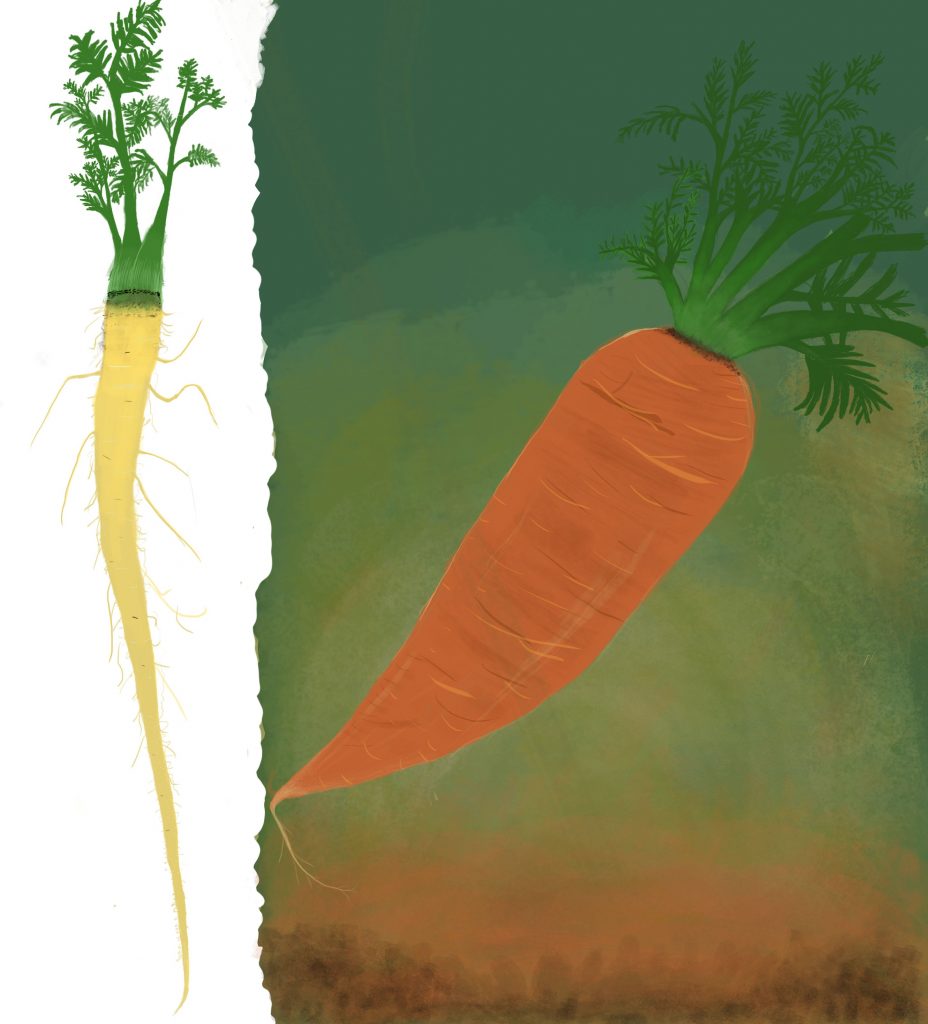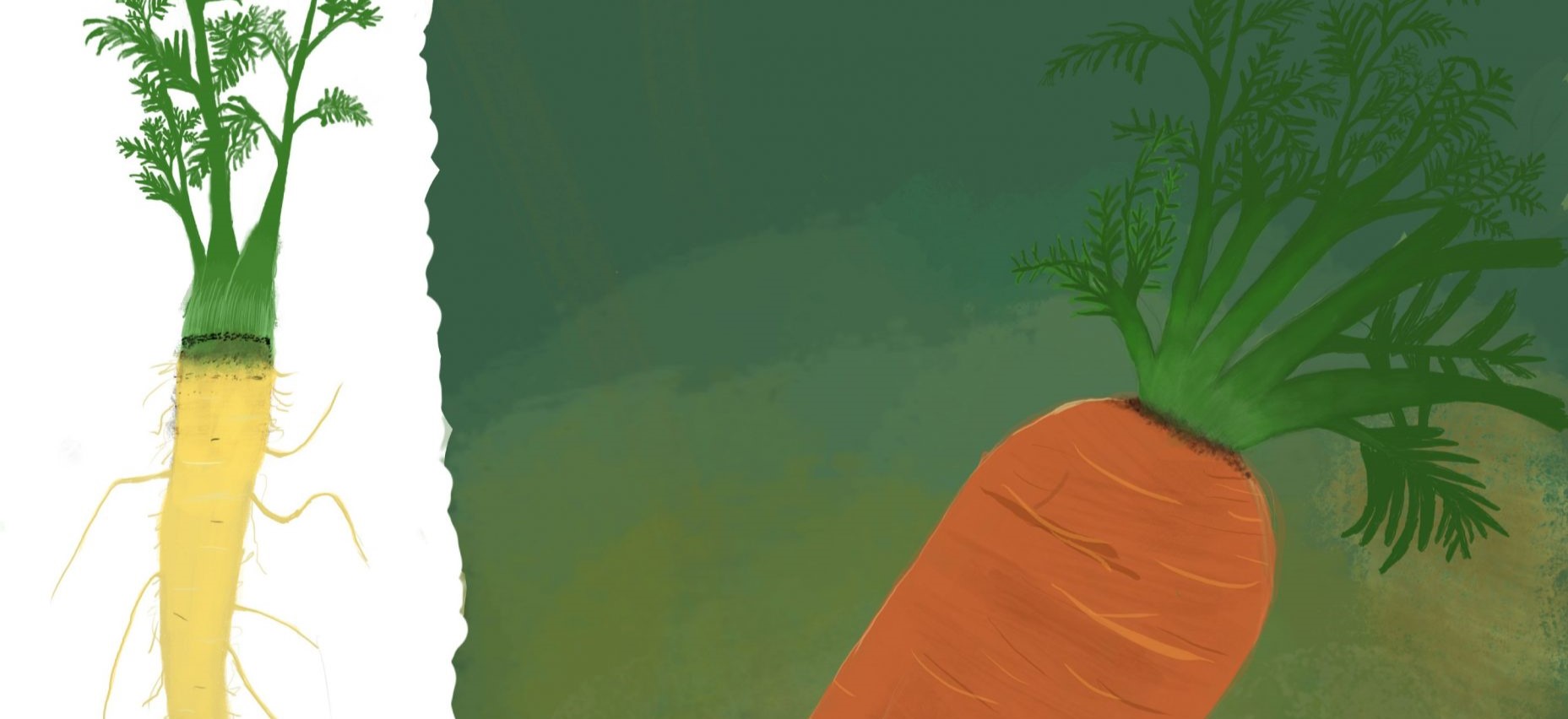
Before there were bright orange carrots, there were brown roots.
Crops have evolved over time from their wild forms to more edible species that we today enjoy for the nutritional content, taste, flavour, aesthetics, size, pharmaceutical composition and so much more. The pleasance of today’s crops is the compound interest of centuries of selective breeding through which humans selected and recultivated plants with desirable characteristics. In this article, we share some of the ways life is being introduced into common crops we consume daily.
Domestication
Burning corn—corn on a cob roasted on open fire—is a specialty I cannot imagine my life without. To you it may be corn on a cob on a seafood platter or salad bowl, or sweet corn on a supermarket shelf. Corn is believed to have been domesticated from its wild relative, teosinte, thousands of years ago. Teosinte, still present in Mexico today, has a hardened case around each grain, quite different from corn whose grains are attached to a cob. The diversification between these two species is thought to have arisen from both natural mutation and human selection. Appearance certainly isn’t the only difference they have; the different kinds of corn existing today is evidence to this fact.
Teosinte (left) and corn (right)
Resistance, tolerance and adaptability
Crop protection is a major breeding goal. Plants’ resistance to pests and tolerance to diseases ensure sustainability of life. Climate change begets seasonality and variability, prompting pests to travel far and wide to new, unchartered territories. The result is an intensification of pest and disease problems. Plants’ internal mechanisms need a boost to fight off diseases and stay strong in the face of pests they cannot ward off.
Ralph Waldo Emerson said, “The first wealth is health.” For plants to be healthy, they require an environment in which they can thrive. Unfortunately, that hardly ever is the case and because they are sedentary, the storm meets them right where they are rooted. Breeding to adapt crops to environmental conditions is preparing them for drought, salinity, bad soils, storms… life. Norman Borlaug, the father of the Green Revolution bred wheat from a tall-type to dwarf-type, reducing lodging and immensely enhancing yield.
Yield and sustainability
Just 50 years ago, corn yield was more than 50% less what it is today. Decades-long era studies show the trail of plant breeding in this success. Today, the ability to produce more from less has never been more important. It is no news that the world population is exponentially increasing and climate change is threatening. These, coupled with the inalterability of land size, and the certainty of its rapid degradation and gradual refuelling beg for better yields. A sustainable planet requires efficiency in resource use and management.
Improvement of nutritional content/biofortification
Plant breeders improve the content of proteins, vitamins, minerals, starch, etc. in different crops. Low glycaemic index in rice and higher protein content in pulses are manifestations to plant breeders’ intervention from different ends of the same problem—malnutrition.
Biofortified crops are armed with extra micronutrients necessary for good health. The advantage lies in the dietary provision of micronutrients to people who cannot afford a diverse diet or do not have access to supplements that meet their metabolic needs. Maria Andrade, Robert Mwanga, John Low and Howarth Bouis won the 2016 World Food Prize. They bred and disseminated the orange-fleshed sweet potato endowed with an extra dose of vitamin A.
Palatability, allergens and poison
A walk through the fruits and vegetables’ section on a Saturday morning is therapeutic—the bright colours, sweet aroma and inviting aesthetics. Forget about the sweet aroma of strawberries; it’s too obvious. Eyes can feel the softness of red raspberries from miles away. Appealing food has been proven to spit the feel-good hormone, dopamine, keeping us wanting more in preference of less appealing food. Bitterness, sourness, or pungency leave grimaces on people’s faces and are said to have been used as an evolutionary indicator for safe food.
We, in these times, are benefitting from years of selection that eliminated poisonous, pungent, less palatable food from the human food list. Still, some carrots are stringy while others are brittle and sweet. As for oranges that are as sour as lemons and lime, well… do not ask me what happened. You may have noticed such minute differences that seem insignificant, yet, on a bad day, you would wish them away if you could. Or, they may be grand that you do not buy them at all.
Food allergies and intolerances cause people to shy away from certain produce and products. The effects of food allergens range from mild to lethal, determining who can and cannot use what. Common examples are gluten in cereals and storage proteins in nuts. With the advancement of biotechnology and molecular biology, better crops are being released with less allergens.
Better shelf life
Good shelf life is the reason why a product is confidently transported across the planet, and stored on supermarket and pantry shelves for months before consumption. Shelf life is how long an item can remain safe for consumption after maturity, harvest and post-harvest processing. We all—farmers, shops and consumers—benefit from crops with better shelf lives than before. The tardiness of degradation and the preservation of food nutritional quality evade foodborne illnesses.
Shattering
You have probably never seen bean pods or rice that shatter. So, imagine how frustrating it can be for farmers to groom plants the entire season and then pick the harvest—if still edible—from the ground, grapple with shattering pods or are compelled to harvest before maturity to evade losing their produce. Grains and pulses group some of the world’s most common staples—rice, wheat, beans, peas etc… whose wild forms experience shattering. These and so many other crops have been actively selected against shattering by farmers and plant breeders.
Cooking time
It may come to you as a surprise, a relief or both to know that breeding to reduce cooking time is an actual thing. If you have ever boiled beans for two hours, you would know how daunting and costly it is. I have, so I do, and so does my grandma. Faster cooking crops reduce energy consumption and cooking time.
The contribution of plant breeding to crop advancement echoes from a more sustainable, healthy planet to the food on your plate.
“The secret of improved plant breeding, apart from scientific knowledge, is love.” ~ Luther Burbank”

